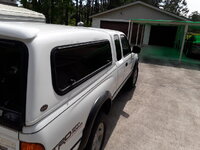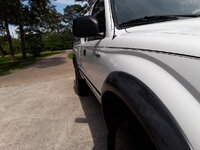I have always run 20W-50 in every vehicle I've ever owned b/c I erroneously believed that heavier oil was a better way to lubricate all motors and I wanted to take the best care of my cars that I could so that (hopefully) my cars would take good care of me. My 4Rnr's seals didn't leak when I got it @ 160k. However, I do not know if in the time I've had it (an additional 100k) its seals have aged/worn/degraded, etc. enough to begin leaking when I do switch "down" to the appropriate (but thinner viscosity) oil. I certainly hope not, but it seems (to me) to be a reasonable fear. Inevitably, I'll find out soon.
I said that heavy oil is (@ best) a temporary solution to leaky seals b/c I've also heard that if one does spot a few fresh drips in their driveway, (where there previously had been none) that one can bump-up a weight or two and it'll get them by until they can make their diagnosis & repair arrangements. This may or may not be accurate info (I dunno; I'm a noob (both to this forum and also to correctly understanding the proper usage of motor oils)) but I've nonetheless anecdotally heard that & read it on multiple occasions, including recently on BITOG.
Since my heavyweight oil usage is bourn of complete ignorance but the best intentions, my current desire to correctly understand is also bourn of the same intent, while hopefully ameliorating my ignorance. I used 20W-50 because I thought I was giving my cars the best oil I could. Clearly I have NOT been accomplishing my intended objective despite my best intentions. So my ultimate question is, what is the very best oil I can finally give my beloved old 4Rnr? If its seals start leaking subsequent to application of the correct oil weight, then that'll unfortunately be the next bridge to cross.
Now that I (more) correctly understand oil viscosities, (i.e.: heavier AIN'T better) I'm leaning hard toward 10W-30 b/c my manual says 10W-30 for climates over 100°F, which I definitely get here, and the 5W-30 (per the manual) is recommended up to 100°F, while protecting better at temps which range far lower than the ones my car is exposed to.
My dilemmas have become certifications & standards (or lack there of, or "meets and exceeds") and specific brands, because it's easy to find 5W-30 that meets or exceeds current API service (this assumes backwards compatibility to "SJ" in my case), ILSAC GF-6, and dexos1 gen3, etc., but finding all those certs in one specific 10W-30 weight with superior seal conditioners and superior varnish & sludge cleaners is proving to be a bit more elusive so far. Here's where we get into "meets or exceeds" without the officially licensed (or paid for) rubber stamp(s).
I'm also leaning toward the Amsoil Signature Series (yeah, I know: 6 quarts will be about $100 US (+tax & shipping)). And if my seals start dripping, I'm quickly gonna need that leftover 1/2 qt. If it's "the best" I really don't care about the price, but if it's snake oil, eff 'em. I haven't read enough forum posts yet to accurately glean if Amsoil is in fact a really really fabulous motor oil, or if it's quality is, shall we say, not quite commensurate with its price, or if it's somewhere in between; however, I can tell from my readings this past week, that among some, Amsoil products do have a stigma (for lack of a better term) associated with their price point vs. perceived performance. And I think there are a few other "designer" oil brands out there that this may also apply to.
M1 HM 10W-30 is missing a few certs, but many ppl here swear by it; M1 HM would be about $24 cheaper for 6 quarts. 24 Bucks is 24 bucks, but not a deciding factor unless all else is equal. However near as I can tell so far, there's no intrinsic way to really know because, per each company's marketing literature (& this seems to be the case for all major motor oil makers): Competitor A's premium product protects X% better than Competitor B's standard product, and vise versa and so on. However M1 HM will likely be my go to if I find too much negative Amsoil feedback.
I know either will serve well, but if one will actually, factually, really, truthfully, honestly serves little better - even if its $24 more - then that's my oil. My old 4Rnr provides 2 very important functions: first, it gets me to work & to my woman, and second, it gets me the hell away from both of those. And after reliably serving more miles than there are between here and the moon, while under less than ideal lubricatory conditions, imo it deserves to finally have whatever constitutes "the good stuff". All I know is this: despite my woeful ignorance, I've only ever wanted to give it the best oil I can, and until 2 weeks ago I thought that was saying to the service rep, "20W-50".
So much for NOT not overthinking, and thank you!
I said that heavy oil is (@ best) a temporary solution to leaky seals b/c I've also heard that if one does spot a few fresh drips in their driveway, (where there previously had been none) that one can bump-up a weight or two and it'll get them by until they can make their diagnosis & repair arrangements. This may or may not be accurate info (I dunno; I'm a noob (both to this forum and also to correctly understanding the proper usage of motor oils)) but I've nonetheless anecdotally heard that & read it on multiple occasions, including recently on BITOG.
Since my heavyweight oil usage is bourn of complete ignorance but the best intentions, my current desire to correctly understand is also bourn of the same intent, while hopefully ameliorating my ignorance. I used 20W-50 because I thought I was giving my cars the best oil I could. Clearly I have NOT been accomplishing my intended objective despite my best intentions. So my ultimate question is, what is the very best oil I can finally give my beloved old 4Rnr? If its seals start leaking subsequent to application of the correct oil weight, then that'll unfortunately be the next bridge to cross.
Now that I (more) correctly understand oil viscosities, (i.e.: heavier AIN'T better) I'm leaning hard toward 10W-30 b/c my manual says 10W-30 for climates over 100°F, which I definitely get here, and the 5W-30 (per the manual) is recommended up to 100°F, while protecting better at temps which range far lower than the ones my car is exposed to.
My dilemmas have become certifications & standards (or lack there of, or "meets and exceeds") and specific brands, because it's easy to find 5W-30 that meets or exceeds current API service (this assumes backwards compatibility to "SJ" in my case), ILSAC GF-6, and dexos1 gen3, etc., but finding all those certs in one specific 10W-30 weight with superior seal conditioners and superior varnish & sludge cleaners is proving to be a bit more elusive so far. Here's where we get into "meets or exceeds" without the officially licensed (or paid for) rubber stamp(s).
I'm also leaning toward the Amsoil Signature Series (yeah, I know: 6 quarts will be about $100 US (+tax & shipping)). And if my seals start dripping, I'm quickly gonna need that leftover 1/2 qt. If it's "the best" I really don't care about the price, but if it's snake oil, eff 'em. I haven't read enough forum posts yet to accurately glean if Amsoil is in fact a really really fabulous motor oil, or if it's quality is, shall we say, not quite commensurate with its price, or if it's somewhere in between; however, I can tell from my readings this past week, that among some, Amsoil products do have a stigma (for lack of a better term) associated with their price point vs. perceived performance. And I think there are a few other "designer" oil brands out there that this may also apply to.
M1 HM 10W-30 is missing a few certs, but many ppl here swear by it; M1 HM would be about $24 cheaper for 6 quarts. 24 Bucks is 24 bucks, but not a deciding factor unless all else is equal. However near as I can tell so far, there's no intrinsic way to really know because, per each company's marketing literature (& this seems to be the case for all major motor oil makers): Competitor A's premium product protects X% better than Competitor B's standard product, and vise versa and so on. However M1 HM will likely be my go to if I find too much negative Amsoil feedback.
I know either will serve well, but if one will actually, factually, really, truthfully, honestly serves little better - even if its $24 more - then that's my oil. My old 4Rnr provides 2 very important functions: first, it gets me to work & to my woman, and second, it gets me the hell away from both of those. And after reliably serving more miles than there are between here and the moon, while under less than ideal lubricatory conditions, imo it deserves to finally have whatever constitutes "the good stuff". All I know is this: despite my woeful ignorance, I've only ever wanted to give it the best oil I can, and until 2 weeks ago I thought that was saying to the service rep, "20W-50".
So much for NOT not overthinking, and thank you!




